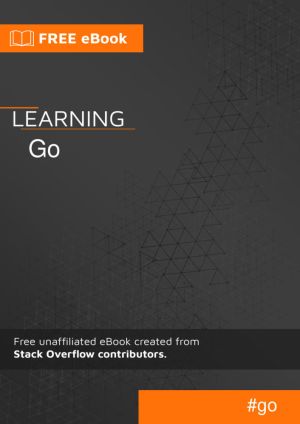Learning Go
by Stack Overflow Community
DescriptionTable of ContentsDetailsHashtagsReport an issue 






Book Description
Go is a statically typed, compiled programming language designed at Google. It is an unofficial and free Go book created for educational purposes. All the content is extracted from Stack Overflow Documentation, which is written by many hardworking individuals at Stack Overflow.This open book is licensed under a Creative Commons License (CC BY-SA). You can download Learning Go ebook for free in PDF format (2.6 MB).
Table of Contents
Chapter 1
Getting started with Go
Chapter 2
Arrays
Chapter 3
Base64 Encoding
Chapter 4
Best practices on project structure
Chapter 5
Branching
Chapter 6
Build Constraints
Chapter 7
cgo
Chapter 8
cgo
Chapter 9
Channels
Chapter 10
Closures
Chapter 11
Concurrency
Chapter 12
Console I/O
Chapter 13
Constants
Chapter 14
Context
Chapter 15
Cross Compilation
Chapter 16
Cryptography
Chapter 17
Defer
Chapter 18
Developing for Multiple Platforms with Conditional Compiling
Chapter 19
Error Handling
Chapter 20
Executing Commands
Chapter 21
File I/O
Chapter 22
Fmt
Chapter 23
Functions
Chapter 24
Getting Started With Go Using Atom
Chapter 25
gob
Chapter 26
Goroutines
Chapter 27
HTTP Client
Chapter 28
HTTP Server
Chapter 29
Images
Chapter 30
Inline Expansion
Chapter 31
Installation
Chapter 32
Installation
Chapter 33
Interfaces
Chapter 34
Iota
Chapter 35
JSON
Chapter 36
JWT Authorization in Go
Chapter 37
Logging
Chapter 38
Loops
Chapter 39
Maps
Chapter 40
Memory pooling
Chapter 41
Methods
Chapter 42
mgo
Chapter 43
Middleware
Chapter 44
Mutex
Chapter 45
Object Oriented Programming
Chapter 46
OS Signals
Chapter 47
Packages
Chapter 48
Panic and Recover
Chapter 49
Parsing Command Line Arguments And Flags
Chapter 50
Parsing CSV files
Chapter 51
Plugin
Chapter 52
Pointers
Chapter 53
Profiling using go tool pprof
Chapter 54
Protobuf in Go
Chapter 55
Readers
Chapter 56
Reflection
Chapter 57
Select and Channels
Chapter 58
Send/receive emails
Chapter 59
Slices
Chapter 60
SQL
Chapter 61
String
Chapter 62
Structs
Chapter 63
Templates
Chapter 64
Testing
Chapter 65
Text + HTML Templating
Chapter 66
The Go Command
Chapter 67
Time
Chapter 68
Type conversions
Chapter 69
Variables
Chapter 70
Vendoring
Chapter 71
Worker Pools
Chapter 72
XML
Chapter 73
YAML
Chapter 74
Zero values
Chapter 75
Zero values
Book Details
Title
Learning Go
Subject
Computer Science
Publisher
RIP Tutorial
Published
2019
Pages
305
Edition
1
Language
English
PDF Size
2.6 MB
License

Related Books
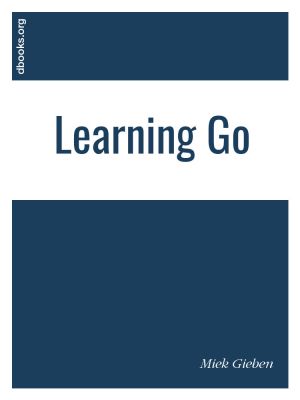
This is an introduction to the Go language from Google. Its aim is to provide a guide to this new and innovative language.
The intended audience of this book is people who are familiar with programming and know multiple programming languages,be it C, C++, Perl, Java, Erlang, Scala or Haskell. This is not a book which teaches you how to program, ...
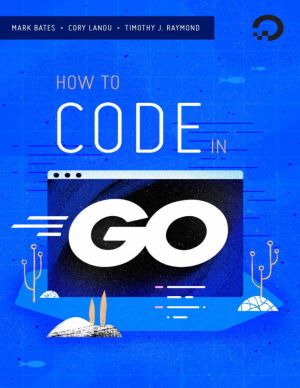
This book is designed to introduce you to writing programs with the Go programming language. You'll learn how to write useful tools and applications that can run on remote servers, or local Windows, macOS, and Linux systems for development.
The topics that it covers include how to:
- Install and set up a local Go development environment on...
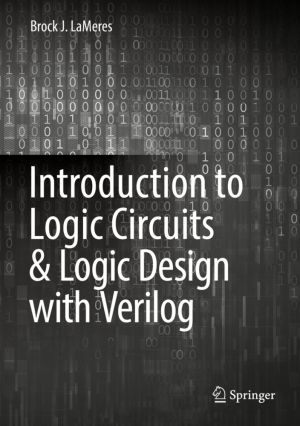
This book for courses in Digital Systems Design introduces students to the fundamental hardware used in modern computers. Coverage includes both the classical approach to digital system design (i.e., pen and paper) in addition to the modern hardware description language (HDL) design approach (computer-based). Using this textbook enables readers to ...

This book for courses in Digital Systems Design introduces students to the fundamental hardware used in modern computers. Coverage includes both the classical approach to digital system design (i.e., pen and paper) in addition to the modern hardware description language (HDL) design approach (computer-based). Using this textbook enables readers to ...
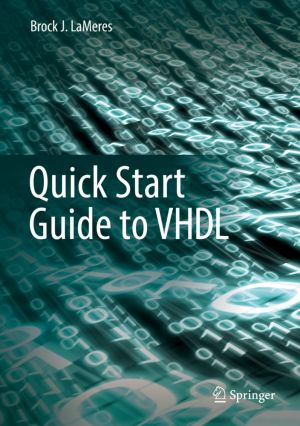
This book provides a starter's guide to VHDL. This book can be used in conjunction with a one-semester course in Digital Systems Design or on its own for designers who only need an introduction to the language. This book is designed to provide a bottoms-up approach to learning the VHDL language. This design supports a course in which foundatio...
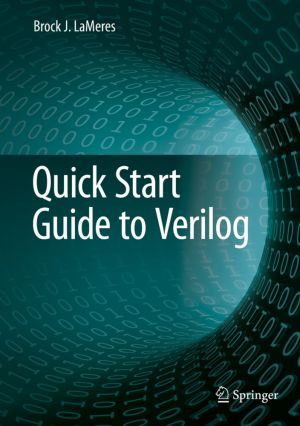
This book provides a starter's guide to Verilog, to be used in conjunction with a one-semester course in Digital Systems Design, or on its own for readers who only need an introduction to the language. This book is designed to match the way the material is actually taught in the classroom. Topics are presented in a manner which builds foundati...

